Medically-managed Hospital in the Home: 7 year study of mortality and unplanned interruption
Michael Montalto A B C , Benjamin Lui A , Ann Mullins A and Katherine Woodmason AA Epworth Hospital in the Home, 89 Bridge Rd, Richmond, VIC 3121, Australia.
B Royal Melbourne Hospital, Hospital in the Home, Grattan St, Parkville, VIC 3052, Australia.
C Corresponding author. Email: michael.montalto@epworth.org.au
Australian Health Review 34(3) 269-275 https://doi.org/10.1071/AH09771
Submitted: 8 April 2009 Accepted: 15 February 2010 Published: 25 August 2010
Abstract
Background. Hospital in the Home (HIH) research is characterised by small samples in new programs. We sought to examine a large number of consecutive HIH admissions over many years in an established, medically-managed HIH service in to determine whether: (1) HIH is a safe and effective method of delivering acute hospital care, under usual operating conditions in an established unit; and (2) what patient, condition and treatment variables contribute to a greater risk of failure.
Method. A survey of all patients admitted to a medically-managed HIH unit from 2000–2007.
Results. A total of 3423 admissions to HIH were examined. Of these 2207 (64.5%) were admitted directly into the HIH from Emergency Department or rooms, with the remainder admitted from hospital wards. A total of 26 653 HIH bed days were delivered, with a mean of 9.3 nursing visits and 4.1 medical visits per admission. A total of 143 patients (4.2%) required an interruption via an unplanned return to hospital; 106 (3.1%) did not subsequently return to HIH. The commonest reasons for unplanned returns to hospital were: no clinical improvement; cardiac conditions; fever; breathlessness and pain. Patients over the age of 50, and those receiving intravenous antibiotic therapy, were more likely to require a return to hospital. Two patients died unexpectedly while in HIH, and a further three patients died unexpectedly after their unplanned return to hospital. This is a total unexpected mortality rate of 0.15%.
Conclusion. This sample of HIH patients is five times the number of HIH patients ever enrolled in randomised trials studies of this area. Further, outcomes were achieved in ‘ordinary’ working conditions over a long time period. Care was completed without interruption (return to hospital) in 95.8% of all episodes. Interruption was associated with patients referred from inpatient wards, older patients, and patients who were treated with intravenous antibiotics. Patients referred from Emergency Departments experienced fewer interruptions. Nursing home residents were no more likely to require an interruption to their HIH care.
What is known about the topic? Hospital in the Home is the delivery of acute hospital services to patients at home. There is no consensus on the best model of HIH. Studies of HIH have small sample sizes, so support for HIH is often qualified.
What does this paper add? This paper describes activity and outcomes for 3423 consecutive patients admitted into a medically-managed HIH over 7 years. This represents an extensive long-term survey of HIH patient care outcomes.
What are the implications for practitioners? Medically-managed HIH is able to deliver acute hospital care with low rates of unexpected mortality and unplanned returns to hospital. Trials using low frequency events such as mortality and delirium as outcomes will require very large samples, and such large trials are unlikely to occur. The impact of medically-managed HIH on access to acute hospital services for certain diagnostic groups could be significant and deserves further expansion. The concept of hospitalisation can be refined to include HIH.
Background
Hospital in the Home (HIH) represents an important shift in the delivery of acute medical services normally associated with traditional hospital inpatient care. Literature that examines the safety and effectiveness of HIH has grown over the last two decades, albeit with limitations. The first limitation is an inconsistency in the definition of HIH, confounding attempts to interpret and compare findings between studies. But other important problems affect research in HIH. Most important among these are that studies of HIH, particularly RCTs, are generally underpowered: they have small numbers, brief intervention periods and focus on the introduction of new (and sometimes temporary) programs.1,2 Publication bias towards these RCT and meta-analyses has exaggerated the impact of those problems.
As a result, Cochrane Reviews of HIH have been guarded and critical.3 A recent meta-analysis came to similar conclusions: it found only 10 published RCT studies of substitutive HIH and not all of those offered direct medical attendance at home.2
Those trials contained data on a total 1327 patients (half that number enrolled in HIH). They highlighted the lack of power of most HIH trials, due partly to small samples and to the low rates of mortality and confusion (commonly used outcome measures) among patients suitable for HIH care. But RCTs cannot account for the unavoidable Hawthorne effect, which is strong in staff motivated to see HIH trials succeed. In units that do not offer 24-h coverage, it is also not clear how some adverse events were monitored.
Similar situations exist in measuring the impact of other innovative hospital services. Berwick recently examined the controversy surrounding the MERIT trial of hospital rapid response teams. Like rapid response teams, Hospital in the Home is a
‘complex, multicomponent, intervention – essentially a process of social change. The effectiveness of these systems is sensitive to an array of influences: leadership, changing environments, details of implementation, organisational history, and much more. In such complex terrain, the RCT is an impoverished way to learn.’4
Given the complexity of establishing, running and funding such a program, this causes hesitation in clinicians and hospital planners.
Aim
This study examines the outcomes of an established, medically-managed Hospital in the Home service. Box 1 describes the HIH service intervention provided. The objective of this study is to examine a large number of consecutive HIH admissions over many years in order to determine whether: (1) medically-managed HIH is a safe and effective method of delivering acute hospital care under usual operating conditions in an established unit; and (2) in delivering medically-managed HIH, what patient, condition and treatment variables contribute to a greater risk of failure.
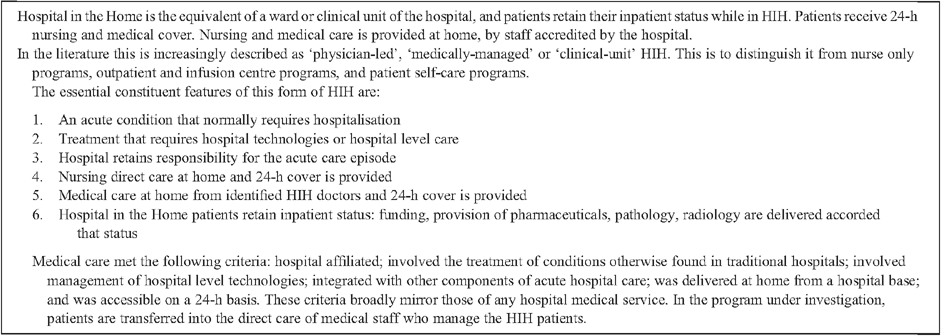
|
Method
This is a study of patient outcomes associated with all admissions to a medically-managed Hospital in the Home based in a large not-for-profit private hospital in Australia.
All admissions from unit inception in March 2000 until 31 December 2007 were included. The unit maintained a standalone database to prospectively record details of the admissions.
The following data were collected:
-
1. Age of patient
-
2. Sex
-
3. Referral source
-
Patients are referred into HIH from three sources:
-
-
3.1. Emergency Department: patients present to the Emergency Department and after investigation, assessment and stabilisation, are referred for direct transfer into the HIH for their ongoing acute care.
-
3.2. Direct referral from rooms: patients present to their family physician or specialist consultant, who after assessment and investigation, refers the patient for ongoing acute care directly to the HIH.
-
3.3. Ward based referral: patients are initially admitted to a traditional ward, and while still on the ward are referred to HIH for transfer to complete their treatment.
-
-
4. Residence for care
-
Patients are cared for by HIH in a residence other than the hospital.
-
-
a. Own home
-
b. Home of a relative, friend, hotel or a hostel
-
c. Nursing home resident
-
-
5. Clinical condition treated
-
The primary condition treated in HIH was described and coded.
-
6. Treatment
-
The primary treatment delivered in HIH is described and coded. Where second and third treatments were identified, data were also collected, but this will not be described in detail. Total number of medical visits and nursing visits to patients was recorded.
Outcomes
Length of stay
-
Total stay in days.
-
Hospital in the Home stay in days.
Unplanned telephone calls
This refers to telephone calls received by HIH on call nursing staff from patients, where such calls were not pre-arranged or prompted. Calls are excluded if they resulted in an unexpected staff callout, or an unplanned return to hospital. Such events are detailed by the on call staff and documented.
Unplanned staff callouts
This refers to visits made by HIH staff to patients, where such a visit is additional to their normal care, and not pre-arranged. Callouts are excluded if they resulted in an unplanned return to hospital. Such events are detailed by on call staff and documented.
Unplanned returns to hospital
This refers to patients who require a return to hospital emergency or wards during their Hospital in the Home stay.5 Permanent returns refer to patients who did not return to HIH. Temporary returns refer to patients who, following a stay in hospital, subsequently returned to HIH to complete their care. The reason for return was described.
Unexpected death
In some circumstances, HIH cares for patients where death is either expected during the current episode of care or a possibility that is accepted. Where the patient’s death was not expected during the current HIH episode, and the patient died in the HIH, it is described in this category. Where the patient was returned to hospital for any reason and the patient died during that hospital stay, it has been classified as death after return to hospital.
Statistical analysis
Data were initially entered into a Microsoft Excel datafile and converted into SPSS (version 17). Descriptive statistics were generated to describe the characteristics of the sample, with Chi-square statistics calculated where appropriate to compare categorical outcomes for specified groups. Due to the skewed distribution of some outcome measures (e.g. length of stay) non-parametric tests (Mann–Whitney U test, Kruskal–Wallis Test) were used to compare groups on continuous outcome measures.
Results
There were a total of 3423 identified episodes of care, of which 1893 (55.3%) men and 1530 (44.7%) women were admitted in the time period. Age distribution is described in Table 1.
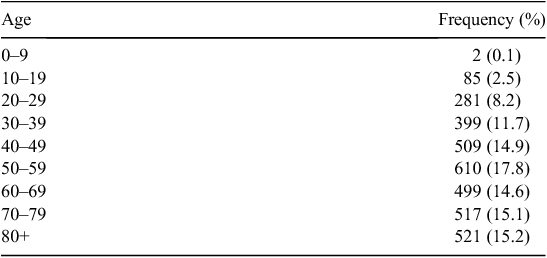
|
A total of 193 patients (5.6%) were residents of nursing homes; 2407 patients (70.3%) were treated in their own homes; and 820 (23.9%) were treated in accommodation other than their usual home, this included relatives’ homes, hostels and hotels.
A total of 2207 patients (64.5%) were referred from either Emergency Department (1790 or 52.3%) or directly from rooms (417, or 12.2%) into Hospital in the Home. The remainder (1208, or 35.3%) were referred from hospital wards. Table 2 describes the conditions treated in this HIH sample.
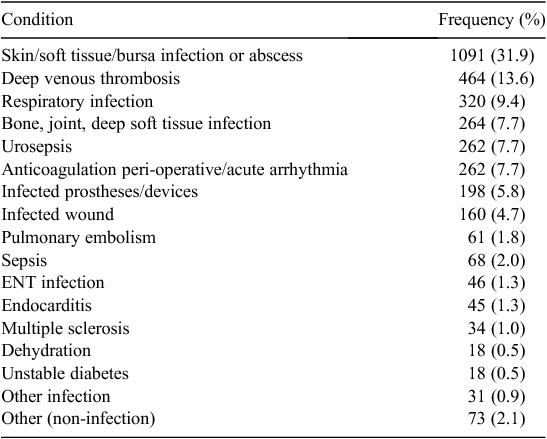
|
There were 14 187 medical visits made to HIH patients, a mean of 4.1 visits per admission (s.d. = 2.7); and 31 751 nursing visits (mean = 9.3 per admission, s.d. = 9.8) were delivered.
The primary treatment delivered in HIH is described in Table 3. In 297 episodes (8.7%), multiple treatments were delivered.
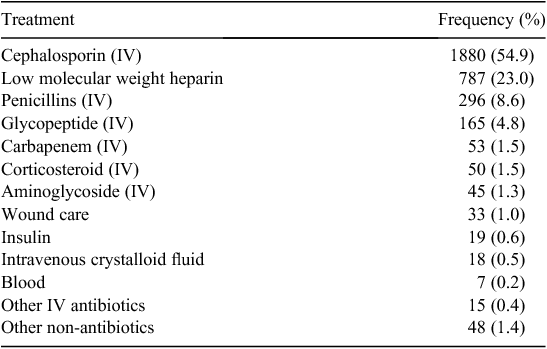
|
A total of 26 653 HIH bed days were delivered (mean = 7.8 days, s.d. = 8.4, range = 1–103). The total bed days associated with these admissions was 31 623 bed days (mean = 9.3, s.d. = 10.6, range = 1–128).
The mean length of stay for patients referred from Emergency Departments (EDs) was 5.1 days (range = 4.95–5.27, s.d. = 3.43) and direct from rooms into HIH was 6.11 days (5.60–6.62, s.d. = 5.25), and the mean length of stay for patients referred from hospital wards was 12.49 days (11.82–13.15, s.d. = 11.75). When the groups referred from EDs and direct from rooms are combined, the mean is 5.3 days (5.14–5.46, s.d. = 3.86). The difference in LOS between the ED and direct-referred patient group and the ward-referred group was significant (P < 0.005).
Outcomes
Unplanned telephone calls
A total of 607 patients (17.7% of all admissions) made unexpected telephone calls during their admission. Patients who made an unplanned telephone call were more likely to have a subsequent return to hospital than those who didn’t (14.5 v. 2.2%, χ2 = 138.006, d.f. = 1, P < 0.001). Patients referred from inpatient wards were more likely to make an unplanned telephone call than those referred from ED and direct (34 v. 19.9%, χ2 = 58.719, d.f. = 1, P < 0.001).
Unplanned staff callouts
There were 177 unexpected staff callouts (5.2% of all admissions) that were required during Hospital in the Home admissions. Table 4 describes the reasons for unplanned staff callouts. Patients transferred from wards were more likely to require an unexpected staff callout than those referred from ED or direct (8.6 v. 3.3%, χ2 = 44.779, d.f. = 1, P < 0.001). Patients receiving antibiotics were more likely to experience a staff callout than patients receiving non-antibiotic therapy (χ2 = 11.615, d.f. = 1, P < 0.001). However, there was no association between age and unexpected staff callouts.
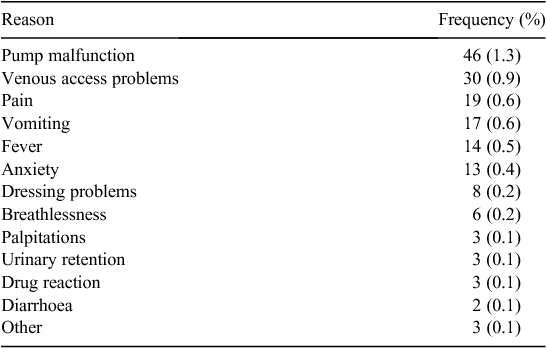
|
Unplanned returns to hospital
A total of 143 episodes of care (4.2% of the total) involved an unplanned return to hospital. Of these, 106 (3.1%) remained in hospital, and 37 (1.1%) subsequently returned to Hospital in the Home to complete their treatment. Reasons for unplanned returns to hospital are outlined in Table 5.
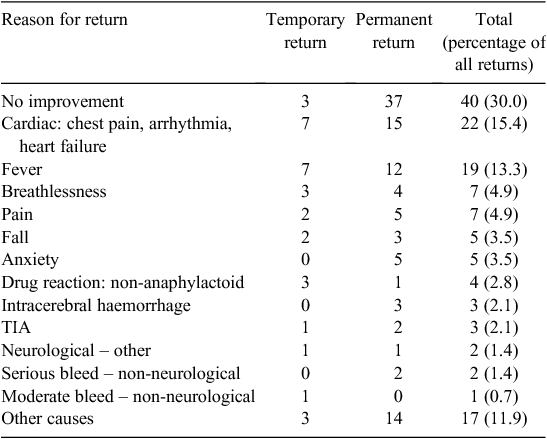
|
No patient was returned to hospital for an anaphylactoid drug reaction, or for new onset delirium. One patient required a return to hospital for alcohol intoxication. Figure 1 describes the rates of return to hospital according to patient age. Figure 2 describes the rate of permanent return to hospital according to the condition treated. Figure 3 describes the rate of return to hospital according to the treatment delivered in HIH. Patients over the age of 50 were more likely to require a return to hospital than patients under 50 (χ2 = 14.308, d.f. = 1, P < 0.005). Patients who received antibiotic therapy (2331, or 68.3%) were more likely to require an unplanned return to hospital than patient receiving non-antibiotic therapy (939, 27.5%) (χ2 = 13.399, d.f. = 2, P = 0.001). There were no significant differences in the rates of return to hospital between men and women, nursing home residents and non-residents, or age.
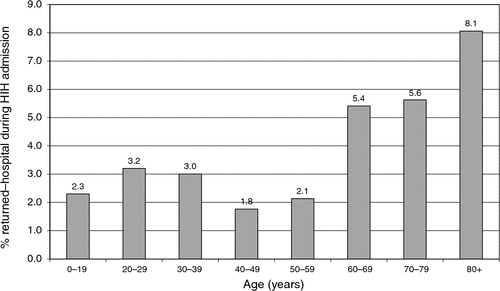
|
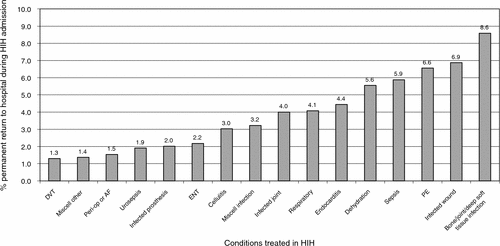
|
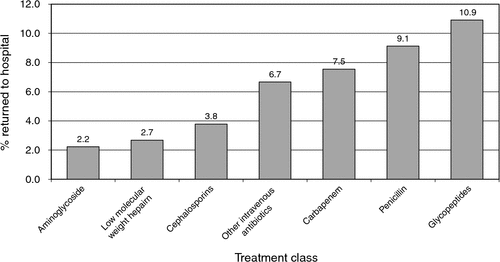
|
Patients transferred from inpatient wards were more likely to require a return to hospital than patients admitted directly into HIH from ED and rooms (6.1 v. 2.9%, χ2 = 20.249, d.f. = 1, P < 0.001)
Patients with an unplanned telephone call were more likely to require a return to hospital compared with patients who did not have an unplanned telephone call (3.6 v. 7.8%, χ2 = 17.389, d.f. = 1, P < 0.001). Similarly, patients who required an unplanned staff callout were significantly more likely to require a return to hospital than for those who did not (12.4 v. 3.6%, χ2 = 33.517, d.f. = 1, P < 0.001).
Unexpected deaths
In five admissions, an expected patient death occurred. Two patients died unexpectedly during their Hospital in the Home stay. An 81-year-old man, treated for urosepsis and with no history of mental illness, committed suicide. A 78-year-old referred for education and supervision of diabetes, died of a sudden cardiac event. During their HIH stays, one made an unexpected telephone call, but no callouts or returns were made. Three patients died unexpectedly after return to hospital.3 A male with infective disciitis on intravenous antibiotics (but no anticoagulation) suffered a major intracerebral bleed with initial collapse and respiratory arrest. A male with olecranon bursitis on intravenous antibiotics was returned to hospital after an asymptomatic bradycardia was incidentally noted. He died of a sudden cardiac arrest during his stay. Finally, an elderly male normally resident in nursing home was treated initially for bronchopneumonia and deteriorated. Within this group, no unexpected telephone calls, or callouts were made before their returns. This is an inclusive unexpected mortality rate of 0.15%.
Conclusion
Our sample of 3423 HIH patients is five times the number of HIH patients ever enrolled in RCT studies of this area, and at the current rate of RCT research, it would take 50 years to recruit that number of HIH patients. Further, these outcomes were achieved in ‘ordinary’ working conditions over a long time period, minimising the Hawthorne effect.
In this study, care was completed without interruption (return to hospital) in 95.8% of all episodes. Interruption was associated with patients referred from inpatient wards, older patients, and patients who were treated with intravenous antibiotics. Patients referred from Emergency Departments experienced fewer interruptions. Nursing home residents were no more likely to require an interruption to their HIH care.
Unexpected mortality was low, and it was not possible to examine associations due to this low incidence. No patient died from, or required transfer to hospital for, anaphylactic shock. This is a reassuring finding for patients and for hospitals, given the important role played by HIH in the delivery of intravenous antibiotic therapy, often by infusion pumps without physical attendance of nursing staff.6 Mortality, confusion and falls are commonly used outcomes in studies comparing HIH and hospital care. In this study, the absolute risk of unexpected mortality, confusion and falls was low. This validates the selection criteria and processes of care in this intervention. We would expect that these events would be also be of low frequency in patients assessed as suitable for HIH, but treated as usual in hospital. The literature supports everything from equivalence to dramatic differences in mortality, confusion and falls between traditional care and HIH care.1,6–8 In studies examining specific populations, such as severe airways disease or cancer, absolute mortality rates might be higher.9
Only five patients were returned to hospital for non-clinical reasons relating to their anxiety about ongoing HIH admission. This supports previous observations that patient satisfaction and acceptability in HIH is strongly influenced by the availability of regular medical home visits, 24-h response to telephone calls and call out ability.10,11
The important outcomes of unexpected visits and unexpected returns to hospital are confined to HIH patients: there is no direct corollary in non-HIH patients, and therefore a control group would not be able to address these outcomes.5 The outcome of care interruption does allow comparison between different models of HIH care delivery. A recent study found that the unplanned return to hospital rate was reduced by 75% through the introduction of HIH medical staff.12
There are shortcomings in this study. Unexpected interruption of care is not necessarily a reflection of poor care or assessment, and may indeed reflect the severity of illness and co-morbidity; however, it does constitute an undesirable outcome for patients and hospitals. We cannot objectively describe the severity within each condition group, other than to state that these patients would otherwise have been admitted into, or remained in, hospital. We offer no comparison group for length of stay, so we are open to the criticism that our outcomes were based on longer lengths of stay. Finally, we have evaluated our own work in our own unit, and therefore our objectivity might be questioned.
Hospital in the Home aims to treat acutely unwell patients who would otherwise remain in hospital. Even in the best supported HIH, there are risks associated with the inherently reduced level of supervision. The challenge of this form of acute care is to establish, assess and modify the risk of unexpected adverse events (of which death is the most important) to acceptable levels. We believe that the specific type of Hospital in the Home intervention described in this large study offers benefits in achieving the aim of care with as few adverse events as possible. It will be some time (if ever) before there is adequate consistency in model definition to allow large multicentre randomised trials with enough power to make RCT a worthwhile activity.
HIH is a challenge to our firmly structured health universe, where community services and hospital services travel in distinct orbits. But technology and patient preference is constantly developing to the extent that the basis for this separation is, in some circumstances, predominantly cultural. This is no less a barrier than technology delivery, but it deserves to be acknowledged as such.
Competing interests
The authors declare that there are no competing interests.
[1] Ram FS, Wedzicha JA, Wright J, Greenstone M. Hospital at home for patients with acute exacerbations of chronic obstructive pulmonary disease: systematic review of the evidence. BMJ 2004; 329(7461): 315.
| Crossref | GoogleScholarGoogle Scholar | PubMed |

[2] Shepperd S, Doll H, Angus RM, Clarke MJ, Iliffe S, Kalra L, Aimonio Ricauda N, Tibaldi V, Wilson AD. Avoiding hospital admission through provision of hospital care at home: a systematic review and meta-analysis of individual patient data. CMAJ 2009; 180(2): 175–82.
| Crossref | GoogleScholarGoogle Scholar | PubMed |

[3] Shepperd S, Illife S. Hospital in the home versus inpatient care. Cochrane Database System Rev 2005; 2005(3): CD000356.

[4] Berwick DM. The science of improvement. JAMA 2008; 299(10): 1182–4.
| Crossref | GoogleScholarGoogle Scholar | PubMed | CAS |

[5] Montalto M, Portelli R, Collopy B. Measuring the quality of Hospital in the Home care. Int J Qual Health Care 1999; 11 413–8.
| Crossref | GoogleScholarGoogle Scholar | PubMed | CAS |

[6] Tice A, Rehm SJ, Dalovisio JR, Bradley JS, Martinelli LP, Graham DR, Gainer RB, Kunkel MJ, Yancey RW, Williams DN. Practice guidelines for outpatient parenteral antimicrobial therapy. CID 2004; 38 1651–72.
| Crossref | GoogleScholarGoogle Scholar |

[7] Caplan GA, Ward JA, Brennan NJ, Coconis J, Board N, Brown A. Hospital at home a randomised controlled trial. Med J Aust 1999; 170(4): 156–60.
| PubMed | CAS |

[8] Leff B, Burton L, Mader SL, Naughton B, Burl J, Inouye SK, Greenough WB, Guido S, Langston C, Frick KD, Steinwachs D, Burton JR. Hospital at home: feasibility and outcomes of a program to provide hospital level care at home for acutely ill older patients. Ann Intern Med 2005; 143(11): 798–808.
| PubMed |

[9] Aimonino Ricauda N, Tibaldi V, Leff B, Scarafiotti C, Marinello R, Zanocchi M, Molaschi M. Substitutive hospital at home versus inpatient care for elderly patients with exacerbations of chronic obstructive pulmonary disease: a prospective, randomised controlled trial. J Am Geriatr Soc 2008; 56 493–500.
| Crossref | GoogleScholarGoogle Scholar | PubMed |

[10] Leff B, Burton L, Mader S, Naughton B, Burl J, Clark R, Greenough WB, Guido S, Steinwachs D, Burton JR. Satisfaction with hospital at home care. J Am Geriatr Soc 2006; 54(9): 1355–63.
| Crossref | GoogleScholarGoogle Scholar | PubMed |

[11] Montalto M. Patients and carers satisfaction with Hospital in the Home care. Int J Qual Health Care 1996; 8 243–51.
| Crossref | GoogleScholarGoogle Scholar | PubMed | CAS |

[12] Tran A, Taylor D. Medical model for Hospital in the Home: effect on patient management. Aust Health Rev 2009; 33(3): 494–501.
| Crossref | GoogleScholarGoogle Scholar | PubMed |



